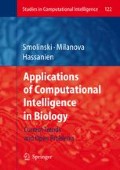Summary
As biologists work with more and more data, there is an increasing need for effective tools to analyze it. Visualization has long been used to communicate experimental results. It is now being used for exploratory analysis where users rapidly determine significant trends and features by working with visual projections of data. A basic workflow is to a) record experimental results or simulate some biological system, b) form hypotheses, c) verify hypotheses with interactive visualizations and statistical methods, d) revise hypotheses, and e) confirm computational results with experiments in wet-lab.
In this chapter we describe a number of visualization methods and tools for investigating large, multidimensional data sets. We focus on approaches that have been used to analyze a model neuron simulation database. These methods are best applied to databases resulting from brute force parameter space exploration or uniform sampling of a biological system; however, their wider applicability is currently under investigation. An example analysis is provided using a generalized tool for interactive visualization called NDVis. We include a summary of NDVis, its plugin architecture, and JavaSim which can be used as a plugin for NDVis or as a stand alone tool for investigating model neuron simulations.
Access this chapter
Tax calculation will be finalised at checkout
Purchases are for personal use only
Preview
Unable to display preview. Download preview PDF.
References
Rasko DA, Myers GSA, Ravel J(2005) Visualization of comparative genomic analyses by blast score ratio., BMC Bioinformatics 6:2
Prinz AA, Billimoria CP, Marder E (2003) An alternative to hand-tuning conductance-based models: Construction and analysis of data bases of model neurons, Journal of Neurophysiology 90:3998–4015
Taylor AL, Hickey TJ, Prinz AA, Marder E (2006) Structure and visualization of high-dimensional conductance spaces, Journal of Neurophysiology 96:891–905
Inselberg A, Dimsdale B (1990) Parallel coordinates: a tool for visualizing multidimensional geometry, In: VIS `90: Proceedings of the 1st conference on Visualization `90, 361–378. IEEE Computer Society Press, Los Alamitos, CA, USA
Chernoff H (1973) The use of faces to represent points in k-dimensional space graphically, Journal of the American Statistical Association 68:361–368
Keim DA (2001) Visual exploration of large data sets, Commun ACM 44(8):38–44
Ward MO (1994) XmdvTool: integrating multiple methods for visualizing multivariate data, In: VIS `94: Proceedings of the conference on Visualization `94, 326–333. IEEE Computer Society Press, Los Alamitos, CA, USA
Witten IH, Frank E (2005) Practical machine learning tools and techniques. Morgan Kaufmann, San Francisco, 2nd edn.
R Development Core Team (2007) R: A Language and Environment for Statistical Computing. R Foundation for Statistical Computing, Vienna, Austria
Eaton JW (2002) GNU Octave Manual. Network Theory Limited
Cook D, Swayne DF (2007) Interactive and Dynamic Graphics for Data Analysis With R and GGobi. Springer
Langton JT, Prinz AA, Hickey TJ (2006) Combining Pixelization and Dimensional Stacking, In: Proceedings of the 2nd International Symposium on Visual Computing (ISVC 2006), vol. 4292 of Lecture Notes in Computer Science, 617–626. Springer
Langton JT, Prinz AA, Hickey TJ (2007) NeuroVis: combining dimensional stacking and pixelization to visually explore, analyze, and mine multidimensional multivariate data, In: Proceedings of SPIE: Visualization and Data Analysis (VDA 2007), vol. 6495, 64950H–1–64950H–12. SPIE
Yang J, Peng W, Ward MO, Rundensteiner EA (2003) Interactive Hierarchical Dimension Ordering, Spacing and Filtering for Exploration of High Dimensional Datasets, In: IEEE Symposium on Information Visualization, 14
Author information
Authors and Affiliations
Editor information
Editors and Affiliations
Rights and permissions
Copyright information
© 2008 Springer-Verlag Berlin Heidelberg
About this chapter
Cite this chapter
Langton, J.T., Gifford, E.A., Hickey, T.J. (2008). Visualization and Interactive Exploration of Large, Multidimensional Data Sets. In: Smolinski, T.G., Milanova, M.G., Hassanien, AE. (eds) Applications of Computational Intelligence in Biology. Studies in Computational Intelligence, vol 122. Springer, Berlin, Heidelberg. https://doi.org/10.1007/978-3-540-78534-7_10
Download citation
DOI: https://doi.org/10.1007/978-3-540-78534-7_10
Publisher Name: Springer, Berlin, Heidelberg
Print ISBN: 978-3-540-78533-0
Online ISBN: 978-3-540-78534-7
eBook Packages: EngineeringEngineering (R0)

